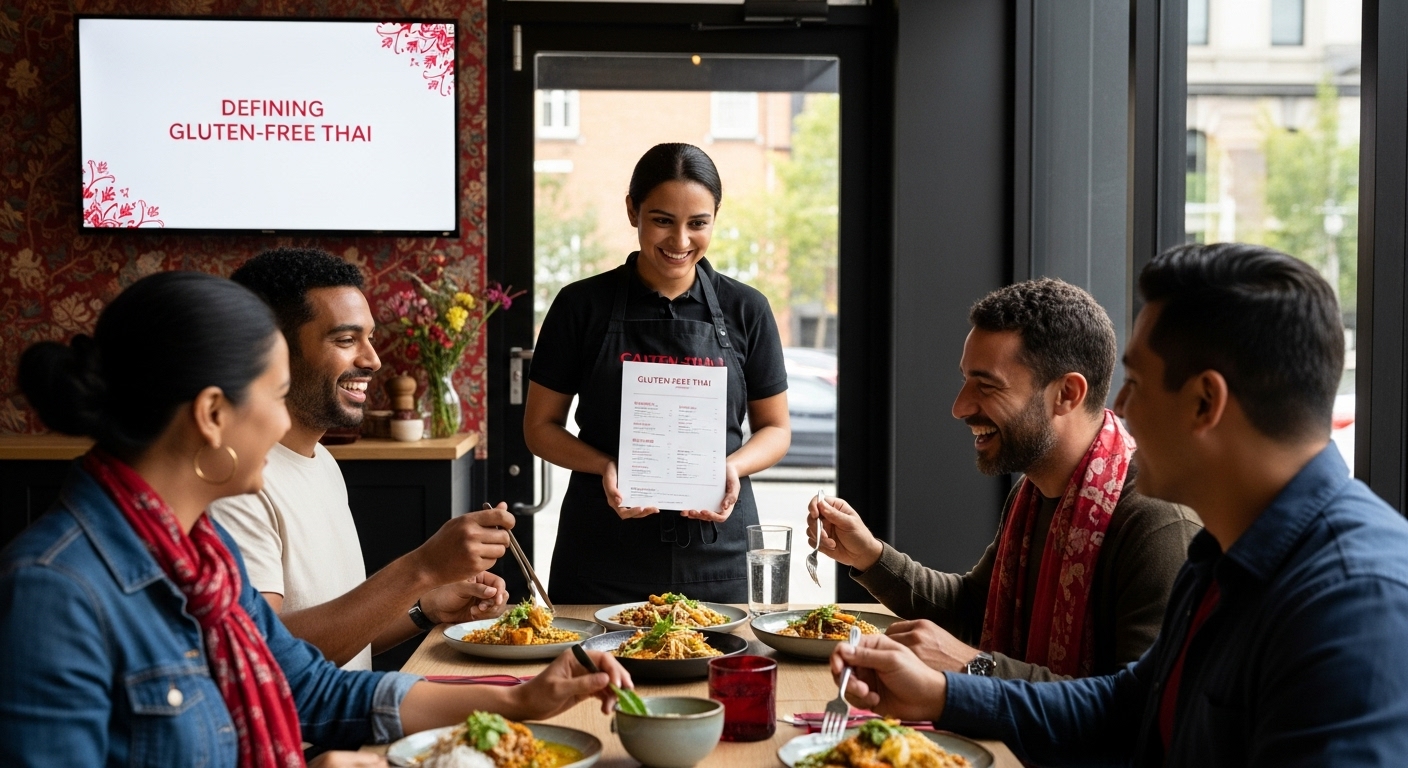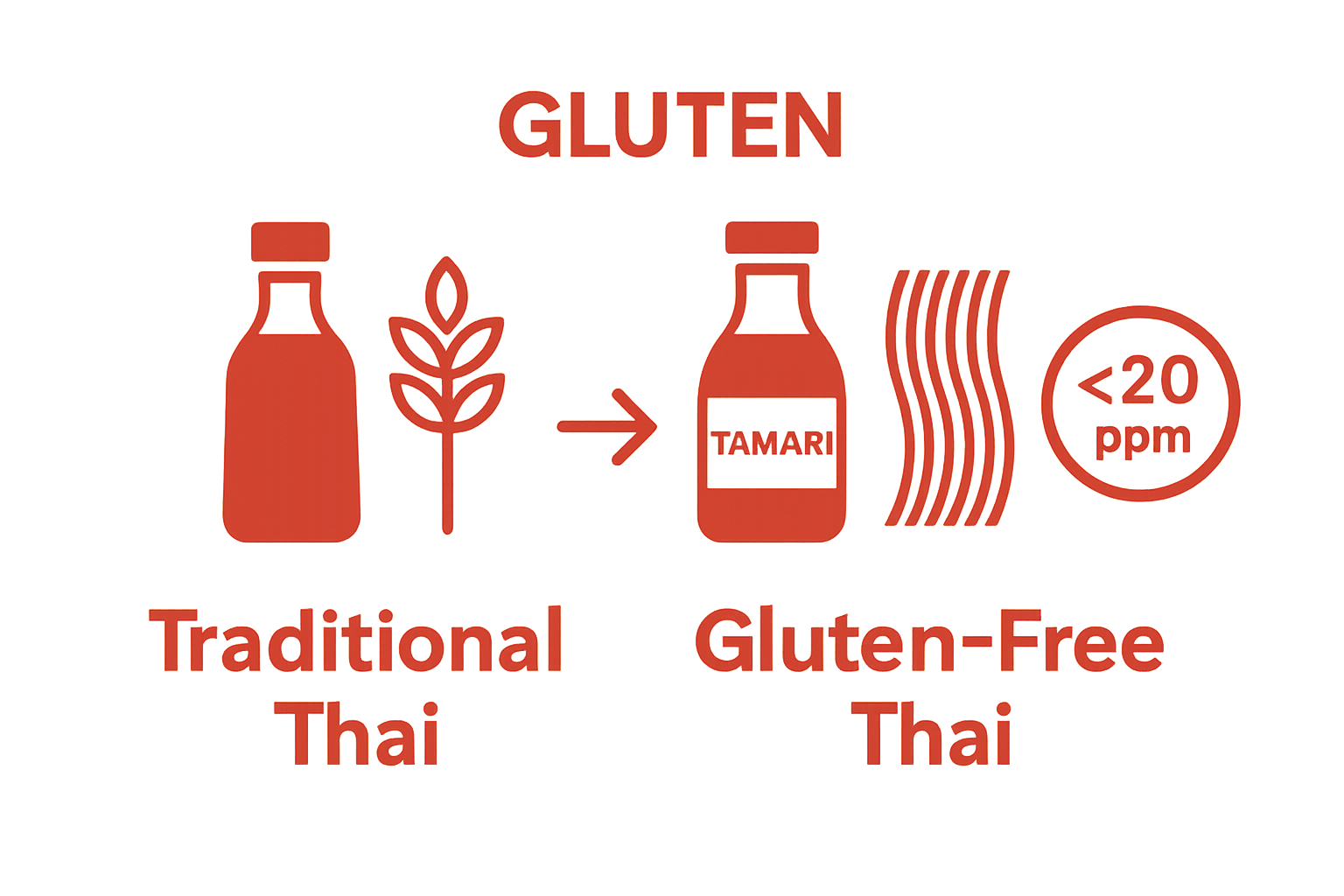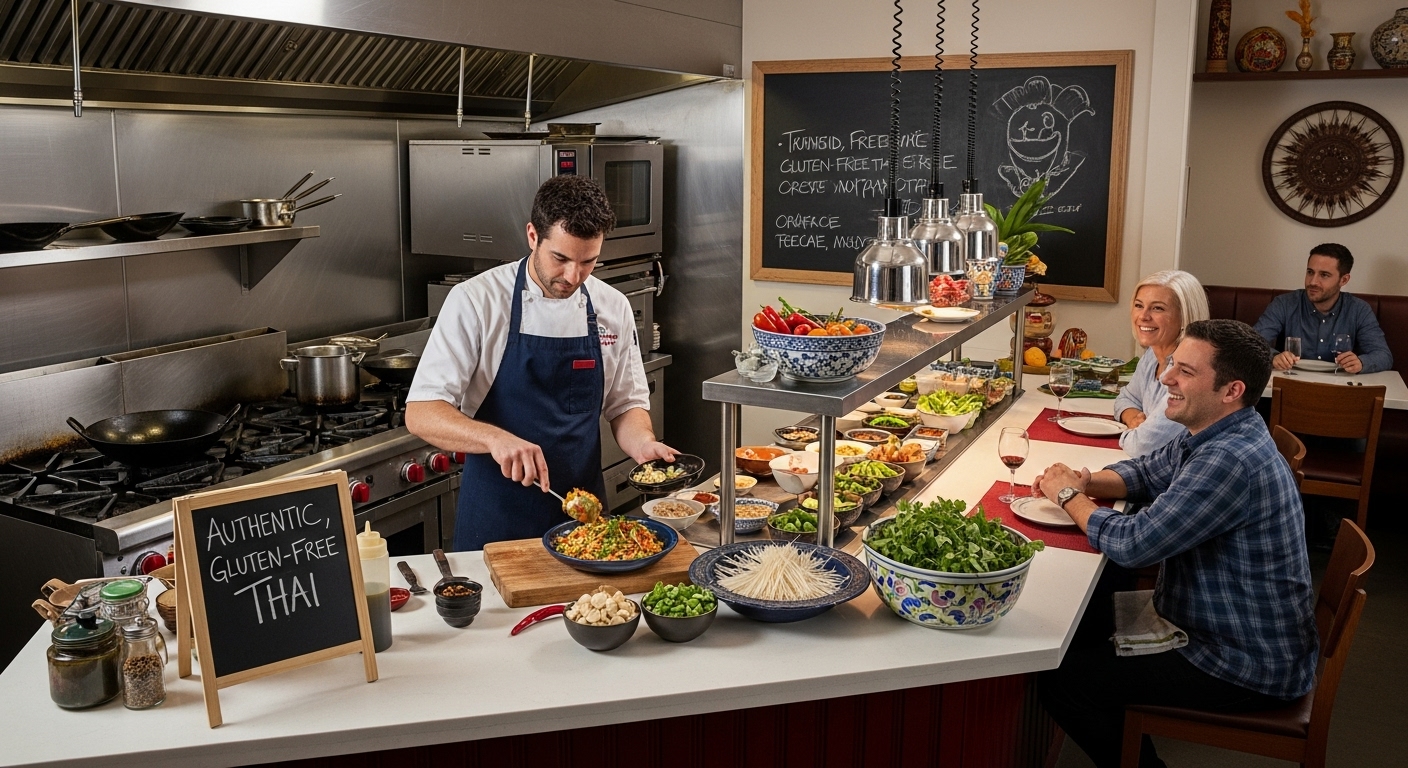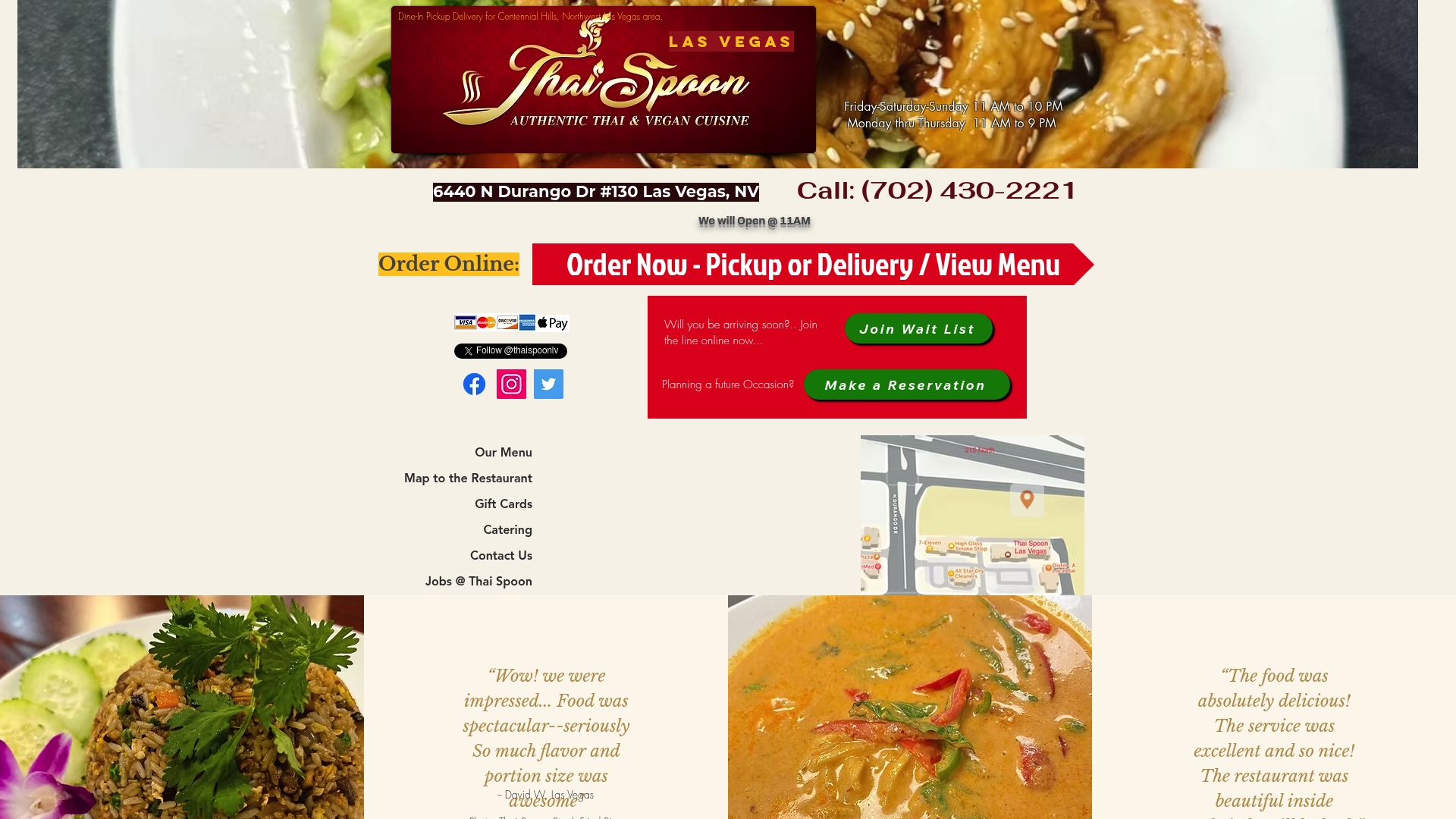What is Gluten-Free Thai Cuisine? Understanding Its Flavors
- mail469793
- Sep 23
- 8 min read

Gluten-free Thai food might sound like a tradeoff for flavor, yet Thai cuisine actually features a huge range of naturally gluten-free options. In fact, over 80 percent of classic Thai dishes use rice noodles or no noodles at all, making gluten an afterthought rather than a main ingredient. Most people assume going gluten-free means giving up on taste, but Thai chefs have turned the challenge into a showcase. The surprising part is, the bold flavors you already love in Thai food come straight from ingredients that never contained gluten to begin with.
Table of Contents
Quick Summary
Takeaway | Explanation |
Focus on naturally gluten-free ingredients | Traditional Thai cuisine uses ingredients like rice noodles, vegetables, and proteins that are safe for gluten-sensitive individuals. |
Substitute gluten-containing sauces wisely | Replace wheat-based soy sauce with tamari or coconut aminos to keep meals gluten-free while maintaining flavor. |
Prevent cross-contamination in preparation | Strict kitchen protocols must be followed, using separate utensils and surfaces to ensure safety for gluten-sensitive diners. |
Gluten-free options reflect cultural adaptability | These adaptations show respect for dietary needs while preserving authentic Thai culinary traditions and flavors. |
Create flavorful gluten-free dishes | Focus on careful ingredient selection to ensure the rich, complex flavor profiles of traditional Thai dishes are preserved in gluten-free formats. |
Defining Gluten-Free Thai Cuisine: What It Is
Gluten-free Thai cuisine represents a thoughtful approach to traditional Thai cooking that eliminates gluten-containing ingredients while preserving the vibrant, complex flavors authentic to Thai culinary traditions. At its core, gluten-free Thai cuisine focuses on preparing dishes that are safe for individuals with celiac disease, gluten sensitivities, or those choosing to avoid gluten in their diet.
The Foundations of Gluten-Free Thai Cooking
Traditional Thai cuisine naturally includes many gluten-free ingredients, which makes adapting recipes relatively straightforward. Our guide on understanding gluten-free options reveals that core ingredients like:
Rice noodles
Fresh vegetables
Herbs and spices
Proteins like chicken, beef, and seafood
Coconut milk
These foundational components are inherently gluten-free and form the basis of most authentic Thai dishes. According to the FDA’s gluten-free guidelines, foods must contain less than 20 parts per million of gluten to be considered safe for consumption.
Key Considerations in Gluten-Free Thai Preparation
The primary challenge in creating gluten-free Thai cuisine lies in managing sauces and seasonings. Traditional soy sauce, which contains wheat, must be replaced with gluten-free alternatives like tamari or coconut aminos. Chefs must carefully select and verify each ingredient to ensure no cross-contamination occurs during preparation.
This meticulous approach guarantees that every dish maintains its authentic flavor profile while remaining completely safe for those avoiding gluten.
The Importance of Gluten-Free Options in Thai Food
Gluten-free options in Thai cuisine are not merely a dietary trend but a critical necessity for individuals managing specific health conditions and lifestyle choices. By providing carefully crafted gluten-free alternatives, Thai restaurants demonstrate a commitment to inclusivity and health-conscious dining experiences.
Health Considerations and Dietary Requirements
For individuals with celiac disease or gluten sensitivities, having reliable gluten-free Thai food options is essential. According to research from the Gluten Intolerance Group, approximately 1% of the population has celiac disease, with many more experiencing gluten sensitivities. These dietary restrictions mean that traditional ingredients like wheat-based soy sauce must be carefully replaced to ensure safe consumption.
Key health considerations include:
Preventing autoimmune responses in individuals with celiac disease
Reducing inflammation for those with gluten sensitivities
Providing safe, flavorful dining options for restricted diets
Supporting overall digestive health
Culinary Innovation and Flavor Preservation
Gluten-free Thai cuisine is not about limitation but about creative adaptation. Discover how local Thai restaurants are crafting gluten-free options that maintain the authentic taste and complex flavor profiles of traditional dishes. Chefs carefully select alternative ingredients like tamari, coconut aminos, and rice-based products to create meals that are both safe and delicious. This approach ensures that dietary restrictions do not compromise the rich culinary heritage of Thai cooking.
How Gluten-Free Thai Dishes Are Created
Creating authentic gluten-free Thai dishes requires a delicate balance of culinary expertise, ingredient selection, and careful preparation techniques. Chefs must thoughtfully replace traditional gluten-containing ingredients while preserving the complex flavor profiles that define Thai cuisine.
The following table summarizes common ingredient substitutions, outlining how traditional Thai ingredients are replaced to create gluten-free versions while maintaining authentic flavor.
Traditional Thai Ingredient | Potential Gluten Content | Gluten-Free Alternative | Purpose in Cuisine |
Wheat-based soy sauce | Yes | Tamari, Coconut Aminos | Adds umami and salty flavor |
Wheat-based noodles | Yes | Rice noodles | Provides base for stir-fried/soup |
Wheat flour (thickening) | Yes | Rice flour, Cornstarch | Thickens sauces and soups |
Regular fish sauce/curry paste | Sometimes (check label) | Gluten-free versions | Adds savory and complex flavors |
Oyster sauce | Sometimes (check label) | Gluten-free oyster sauce | Adds depth to stir-fry dishes |
Strategic Ingredient Substitution
The foundation of gluten-free Thai cooking lies in intelligent ingredient replacement. According to research from the Gluten Intolerance Group, successful gluten-free adaptation involves carefully selecting alternative ingredients that maintain the dish’s authentic taste and texture.
Key ingredient substitutions include:
Replacing wheat-based soy sauce with tamari or coconut aminos
Using rice noodles instead of wheat-based noodles
Selecting cornstarch or rice flour for thickening sauces
Choosing gluten-free fish sauce and curry pastes
Preparation and Cross-Contamination Prevention
Beyond ingredient selection, gluten-free Thai dish creation demands meticulous kitchen practices. Chefs must implement strict protocols to prevent cross-contamination, which involves using separate cooking surfaces, utensils, and preparation areas. Learn more about our gluten-free cooking approach to understand the comprehensive process of creating safe, flavorful dishes.
The creation of gluten-free Thai cuisine is an art form that requires deep understanding of both traditional cooking techniques and modern dietary requirements. By carefully selecting ingredients, employing precise cooking methods, and maintaining rigorous kitchen standards, chefs can transform classic Thai recipes into safe, delicious gluten-free meals that honor the rich culinary heritage of Thailand.
Key Ingredients in Gluten-Free Thai Cooking
Gluten-free Thai cooking transforms traditional recipes by carefully selecting ingredients that are naturally free from gluten while preserving the cuisine’s vibrant, complex flavor profiles. Understanding these core ingredients is crucial for creating authentic, safe, and delicious Thai dishes that cater to various dietary needs.
Essential Gluten-Free Base Ingredients
According to the Gluten Intolerance Group, Thai cuisine offers numerous naturally gluten-free ingredients that form the foundation of most dishes. These fundamental components ensure both safety and exceptional taste for individuals managing gluten-related dietary restrictions.
This table organizes the essential base ingredients and key flavor-enhancing gluten-free alternatives used in Thai cooking, highlighting their culinary functions and importance for gluten-free adaptations.
Ingredient Category | Example Ingredients | Role in Thai Cuisine |
Base Ingredients | Rice, Rice Noodles, Vegetables | Form the main component of most dishes |
Proteins | Chicken, Beef, Shrimp, Tofu | Add substance and texture |
Flavor Bases | Coconut Milk, Palm Sugar, Tamarind Paste | Build sauces, curries, and signature tastes |
Gluten-Free Condiment Alternatives | Tamari, Coconut Aminos, Gluten-Free Fish Sauce | Replace wheat-based options for safety |
Thickening Agents | Rice Flour, Cornstarch | Used to thicken sauces without gluten |
Core gluten-free ingredients include:
Rice and rice noodles
Fresh vegetables and herbs
Proteins like chicken, beef, shrimp, and tofu
Coconut milk and cream
Palm sugar and tamarind paste
Flavor-Enhancing Gluten-Free Alternatives
Successful gluten-free Thai cooking requires strategic substitutions that maintain the cuisine’s signature taste. Chefs carefully select alternative ingredients to replace potential gluten-containing components. Explore our comprehensive guide to gluten-free Thai options to understand how these replacements work.
Key flavor-enhancing alternatives include tamari instead of traditional soy sauce, rice flour for thickening, and specialized gluten-free fish sauces. These ingredients ensure that gluten-free Thai dishes remain true to their culinary roots while providing safe, delectable dining experiences for individuals with gluten sensitivities.

The Cultural Context of Gluten-Free Thai Cuisine
Gluten-free Thai cuisine represents more than a dietary adaptation. It embodies a profound cultural response to evolving global dietary needs while maintaining the essence of traditional Thai culinary practices. This approach demonstrates the remarkable flexibility and respect for individual dietary requirements within Thai food culture.
Cultural Adaptability and Culinary Tradition
According to research published in the Journal of Food Protection, Thai food culture has shown remarkable resilience in adapting to diverse dietary requirements. This adaptability stems from a deep understanding that food is not just sustenance but a holistic experience that must accommodate individual health needs.
Key cultural considerations include:
Respecting individual dietary restrictions
Maintaining authentic flavor profiles
Preserving traditional cooking techniques
Embracing nutritional diversity
Celebrating ingredient versatility
Balancing Tradition with Modern Dietary Needs
Gluten-free adaptations in Thai cuisine represent a thoughtful negotiation between traditional cooking methods and contemporary health consciousness. Learn more about authentic Thai culinary practices to understand how these adaptations honor the cuisine’s rich heritage.
The transformation of Thai dishes to accommodate gluten-free requirements reflects a broader cultural philosophy of inclusivity and compassion. By carefully modifying ingredients and techniques, Thai chefs ensure that individuals with dietary restrictions can still experience the vibrant, complex flavors that define their culinary tradition.

This approach demonstrates that authentic cuisine is not about rigid adherence to historical recipes, but about creating meaningful dining experiences that respect both cultural heritage and individual well-being.
Discover Authentic Gluten-Free Thai Flavors at Thai Spoon Las Vegas
Finding true gluten-free Thai cuisine can be difficult if you want to enjoy vibrant, traditional flavors without worrying about gluten exposure. The article explained how cross-contamination, hidden ingredients, and authentic taste are top concerns for many diners. At Thai Spoon Las Vegas, we put these worries to rest by reimagining classic dishes like Pad Thai and Yellow Curry to meet strict gluten-free standards. Our chefs use clearly labeled ingredients such as rice noodles and tamari, so you never have to sacrifice the food’s complexity or your health.

Come see how local passion and fresh ingredients make all the difference in your next meal. Browse our menu of gluten-free Thai favorites or learn about our vegan options for every lifestyle. Order today or visit us in northwest Las Vegas for safe, delicious dining. Your flavorful gluten-free experience starts now at Thai Spoon Las Vegas.
Frequently Asked Questions
What ingredients are commonly used in gluten-free Thai cuisine?
Gluten-free Thai cuisine typically includes rice noodles, fresh vegetables, herbs, proteins like chicken and seafood, coconut milk, and gluten-free seasonings such as tamari or coconut aminos.
How can I ensure that my Thai food is gluten-free?
To ensure Thai dishes are gluten-free, replace traditional soy sauce with gluten-free alternatives, use rice noodles instead of wheat-based noodles, and choose gluten-free fish sauces and curry pastes while avoiding cross-contamination during preparation.
Is gluten-free Thai cuisine healthy?
Yes, gluten-free Thai cuisine can be healthy, as it emphasizes fresh ingredients, vegetables, and lean proteins. It also accommodates dietary needs for those with celiac disease or gluten sensitivities, promoting overall digestive health.
Can traditional Thai dishes be easily adapted to be gluten-free?
Yes, many traditional Thai dishes can be easily adapted to be gluten-free by substituting gluten-containing ingredients with gluten-free alternatives while maintaining their authentic flavors and textures.
Recommended









Comments